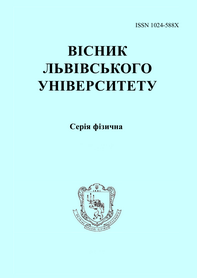DOI: https://doi.org/10.30970/vph.60.2023.166
Magnetoelectric effect in NH2(CH3)2Ga0.935Cr0.065(SO4)2\times6H2O ferroelectric
V. Kapustianyk, Yu. Eliashevskyi, U. Mostovoi, Yu. Chornii

| Visnyk of the Lviv University. Series Physics
60 (2023) ρ. 166-182
DOI: https://doi.org/10.30970/vph.60.2023.166 Magnetoelectric effect in NH2(CH3)2Ga0.935Cr0.065(SO4)2\times6H2O ferroelectricV. Kapustianyk, Yu. Eliashevskyi, U. Mostovoi, Yu. Chornii |  |
(νε μενψε 1800 ηνΰκ³β) The paper is devoted to study of the ferroelectric and magnetic properties as well of the magnetoelectric interactions in NH2(CH3)2Ga0.935Cr0.065(SO4)2\times6H2O (DMAGa0.935Cr0.065S) solid solution. Performed investigations revealed clear evidence of the ferroelectric phase transition connected with a complicated mechanizm of ordering of the different dimethylammonium cations carrying the electric dipoles. The temperature and field dependneces of the magnetic susceptibility testify that the ordered magnetic phase is expected to be observed below 0.36 K. A considerable magnetoelectric interactions were observed within the paramagnetic and simultaneously ferroelectric phase of DMAGa0.935Cr0.065S crystal. The considerable negative magnetoelectric effect was found to be within the ferroelectric phase of this crystal polarization decreases under the action of magnetic field. In the narrow temperature range in vicinity of the Curie point DMAGa0.935Cr0.065S solid solution was found to possess the largest values of the coefficient of ME interaction as well as the largest magnetodielectric effect within the family of ferroics with organic cation and transition metal ions complexes. The model describing the observed variants of the magnetoelectric coupling was proposed. The applied magnetic field through the magnetostriction effect changes the level of the local lattice deformations caused by metal ion substitution. Due to this the applied magnetic field changes Cr-Cr distances and modifies the hydrogen bonds and process of the dimethylammonium groups ordering, affecting the value of spontaneous polarization. The observed maximum of the magnetoelectric coupling coefficient at the Curie point arises due the shift of the first order phase transition under the action of applied magnetic field and the coexistence of the paraelectric and ferroelectric phases in the vicinity of \textit{T}ρ1 respectively.